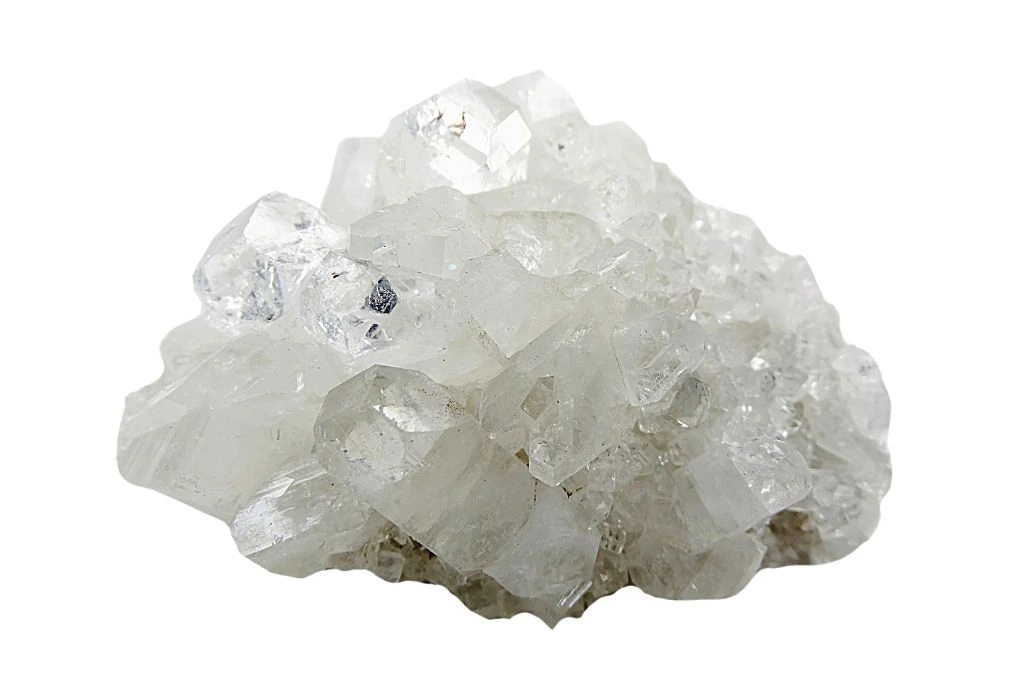Color and Transparency
Apophyllite is renowned for its striking appearance, typically characterized by its colorless or white hue. However, this crystal can also occur in shades of green, yellow, and rarely pink. One of its most captivating features is its exceptional transparency, often appearing glass-like or with a pearly luster that gives it an ethereal quality.
Crystal Structure
The crystal structure of Apophyllite is tetragonal, forming in distinctive pyramid-shaped crystals. These pyramids often have a square base, creating a geometric aesthetic that is both elegant and eye-catching. The crystal frequently forms in clusters, with multiple pyramids growing together to create intricate and visually stunning formations.
Surface Characteristics
Apophyllite crystals are known for their smooth, lustrous surfaces. The faces of the crystals are often highly reflective, giving them a glass-like appearance. In some specimens, a pearly sheen can be observed on certain faces, adding to the crystal’s allure and visual appeal.
Unique Features
One of the most distinctive aspects of Apophyllite is its perfect cleavage in one direction. This property allows the crystal to split cleanly along specific planes, creating smooth, flat surfaces. Another notable characteristic is its fluorescence under ultraviolet light, with some specimens emitting a vibrant green glow that adds to its mystique and appeal among collectors.
Size and Formation
Apophyllite crystals can vary significantly in size, ranging from small, delicate specimens to large, impressive formations. They often occur in association with other minerals, particularly zeolites, creating stunning natural compositions. These crystals are frequently found lining the walls of volcanic rock cavities, adding to their geological interest and significance.
Historical and Cultural Significance of Apophyllite
Apophyllite has been revered for centuries in various cultures for its spiritual and metaphysical properties. Ancient Indian texts mention its use in Ayurvedic practices, where it was believed to promote mental clarity and spiritual growth. In more recent times, it has gained popularity among crystal enthusiasts and alternative healers for its supposed ability to connect the physical and spiritual realms.
Metaphysical Associations
Apophyllite is often associated with the crown chakra and is believed to enhance spiritual awareness and intuition. Many practitioners claim it can facilitate communication with higher realms and spirit guides. The stone is also thought to have a calming effect on the mind, helping to reduce stress and anxiety. Some believe it can promote lucid dreaming and astral projection, making it a popular choice for those interested in exploring altered states of consciousness.
Common Uses and Benefits
In crystal healing practices, Apophyllite is commonly used for meditation and energy work. It is often placed on the third eye or crown chakra during sessions to enhance spiritual connection and insight. Many people keep Apophyllite in their living spaces or workplaces to create a peaceful atmosphere and promote positive energy flow. Some alternative healers use it in crystal grids or layouts to amplify the effects of other stones. Additionally, Apophyllite is believed to have detoxifying properties, with some practitioners recommending it for cleansing negative energies from both the body and the environment.
Modern Applications
Today, Apophyllite is widely used in the wellness and self-care industry. It is incorporated into jewelry, meditation tools, and home decor items. Many modern spiritual practitioners use Apophyllite in combination with other healing modalities, such as Reiki or sound therapy, to enhance their effectiveness. The stone’s aesthetic appeal and supposed metaphysical properties have also made it popular in interior design, where it is often used as a decorative element to create serene and spiritually uplifting spaces.

